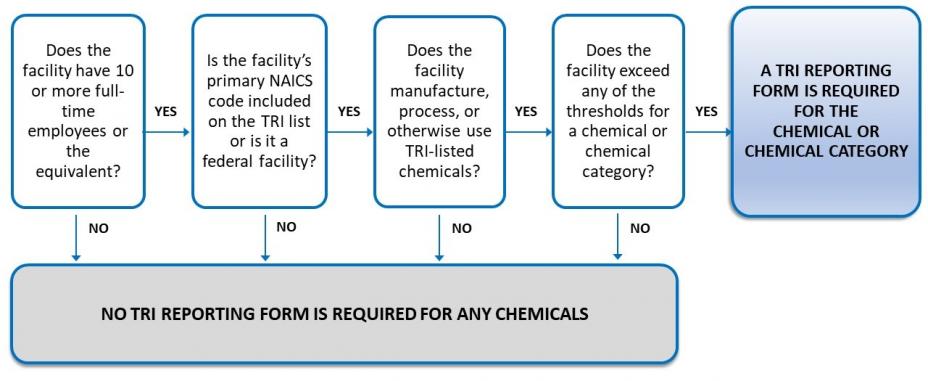Basics of TRI Reporting
Each year, Toxics Release Inventory (TRI) data are submitted by certain industrial facilities and made available to the public.
On this page:
TRI Reporting Criteria
If a facility meets the employee, industry sector, and chemical threshold criteria, it must report to the TRI Program. For more details about the reporting criteria, refer to the TRI Reporting Forms and Instructions.

Facilities that meet all TRI reporting criteria must:
- Submit a TRI Form R for each TRI-listed chemical it manufactures, processes, or otherwise uses in quantities above the reporting threshold. (Note: Facilities may be eligible to submit the shorter Form A if they meet certain criteria. See the TRI Reporting Forms and Instructions for details.)
- Submit each TRI form to both EPA and the state in which the facility is located (or to the appropriate tribe, if located in Indian country).
- Submit each reporting form using TRI-MEweb, EPA's online TRI reporting application.
Data Reported by Facilities
Industrial facilities report data about how they are managing chemical waste through:
- Recycling
- Energy recovery
- Treatment
- Disposal
- Environmental releases
Additionally, facilities tell EPA about how they are reducing the amount of chemical waste that enters the environment and/or how they are preventing waste from being created in the first place.
Annual TRI Data Cycle
 The TRI Program collects, processes and analyzes TRI data on an annual cycle. In addition to activities that occur at specific times of the year, the TRI Program continually conducts data quality checks and provides analytical support for enforcement efforts led by EPA’s Office of Enforcement and Compliance Assurance (OECA).
The TRI Program collects, processes and analyzes TRI data on an annual cycle. In addition to activities that occur at specific times of the year, the TRI Program continually conducts data quality checks and provides analytical support for enforcement efforts led by EPA’s Office of Enforcement and Compliance Assurance (OECA).
January-June: Facilities Prepare and Submit Forms
- TRI Program publishes reporting instructions, updates training materials, and releases a new version of the TRI-MEweb reporting software.
- Facilities prepare and submit TRI forms covering chemical waste management and pollution prevention activities that occurred during the previous calendar year.
July 1: TRI Forms Due to EPA
- Deadline for facilities that meet TRI reporting requirements to submit reporting forms to EPA and the relevant state or tribe.
Mid-July: TRI Preliminary Dataset Available
- Preliminary, facility-level data for the previous calendar year are available in downloadable files on the TRI website and in Envirofacts.
July-October: Ongoing Data Processing and Analysis
- The preliminary dataset is updated as additional reporting forms are processed.
- EPA conducts additional data quality checks, publishes the complete dataset, and begins analyzing the data.
January: TRI National Analysis Available
- EPA publishes the TRI National Analysis, an in-depth look at the previous calendar year's TRI data.
